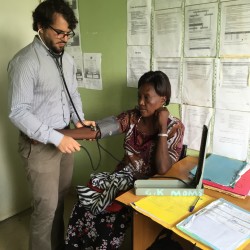Internal Medicine Resident, University of California, San Francisco (UCSF)
Suba/Mbita, April 2016
 I arrived at Remba clinic to a frenetic scene: Fishermen were just arriving on the island in the last week after catches started to pick up. Our boat nudged between five other boats filled with fishermen tossing fish unto the beach. I walked through narrow alleyways to the dispensary at the center of the island, dodging men and women carrying baskets of Ngege tilapia as I walked. I met patients from Uganda, Tanzania, and far away around Kenya who make the long trip to Remba to catch as many fish as possible and take back money to their home villages. The island has more than 800 people despite taking 10 minutes to walk across. About a third of the population is HIV positive, although it is difficult to obtain accurate data because of the mobility of the population. I met a patient who had travelled to Uganda as recently as last week. He talked about the challenges in adhering to ARVs when your schedule changes frequently (fishermen often work at night) and you do not know when you will return to your home clinic.
I arrived at Remba clinic to a frenetic scene: Fishermen were just arriving on the island in the last week after catches started to pick up. Our boat nudged between five other boats filled with fishermen tossing fish unto the beach. I walked through narrow alleyways to the dispensary at the center of the island, dodging men and women carrying baskets of Ngege tilapia as I walked. I met patients from Uganda, Tanzania, and far away around Kenya who make the long trip to Remba to catch as many fish as possible and take back money to their home villages. The island has more than 800 people despite taking 10 minutes to walk across. About a third of the population is HIV positive, although it is difficult to obtain accurate data because of the mobility of the population. I met a patient who had travelled to Uganda as recently as last week. He talked about the challenges in adhering to ARVs when your schedule changes frequently (fishermen often work at night) and you do not know when you will return to your home clinic.
In spite of these challenges, most patients I met were doing incredibly well. So well I felt that as an internist I often did not have much to add to clinical encounters. Nurses and clinical officers see the patients with little physician support, but do count on the support of social workers and community health workers who provide interdisciplinary care, many times within the homes of their patients. The hospital wards are surprisingly empty, and although I met several patients and families, struggling with opportunistic infections and the difficulties of travelling to Homa Bay, a larger city with a CT scanner and more advanced diagnostics, I rarely saw the complications of HIV that I would have expected. Co-infection with TB and malaria was of course common, but these were managed excellently with advanced diagnostics and some medications that are not even available in the United States, even in rural places like Sindo and Mfangano. All of this is testament to the incredible work that the staff in Sindo, Mbita, Mfangano and Remba have accomplished. At my CME, I presented data on percentages of HIV+ patients on ART in Kenya and the United States and the staff was surprised that Homa Bay County was quite competitive with my better resourced country. I leave Kenya humbled by the excellent care that a multidisciplinary network can provide, and I reflect that there is much more work to be done to achieve the degree of interdisciplinary care that FACES has accomplished in the U.S.